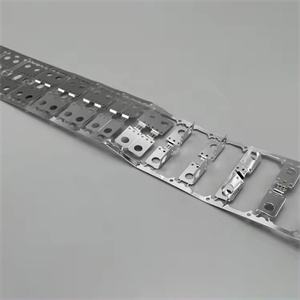Progressive Die Stamping’s blackening treatment is a surface treatment technique mainly used to improve the corrosion resistance, wear resistance, and appearance of stamped parts. The following are the general steps and precautions for blackening treatment of progressive die stamping parts:
Cleaning: First, thoroughly clean the Progressive Die Stamping parts to remove surface oil, dust, rust, and other impurities. The cleaning process can use alkaline cleaning agents, solvents, or high-pressure water flow to ensure that the surface of the stamped parts is clean and free of impurities.
Oil removal: If there is oil stains on the surface of the stamped parts, oil removal treatment is required. This is usually done using organic solvents or alkaline degreasers to ensure that the surface of the stamped parts is clean and free of oil stains.
Blackening treatment:
Choose the appropriate blackening agent: Based on the material of Progressive Die Stamping parts and the desired blackening effect, choose the appropriate blackening agent. Common blackening agents include oxidants, catalysts, etc.
Processing process: Put the cleaned Progressive Die Stamping parts into a blackening agent, and control the processing time and temperature according to the formula and concentration of the blackening agent. Usually, blackening treatment needs to be carried out at a certain temperature and time to ensure the formation and uniformity of the oxide film.
Attention: During the blackening process, it is necessary to strictly control the concentration, temperature, and time of the treatment solution to avoid damage to the stamped parts. At the same time, it is necessary to ensure that the stamped parts are completely immersed in the blackening agent to obtain a uniform oxide film.
Rinsing and drying: After blackening treatment, remove the Progressive Die Stamping parts from the blackening agent and rinse to remove surface residues. After rinsing, dry the stamped parts to prevent damage to the oxide film during subsequent processing.
Subsequent treatment (optional): As needed, the blackened stamped parts can be subjected to subsequent treatment, such as oiling, painting, or packaging, to further improve their corrosion resistance, wear resistance, or decorative properties.
